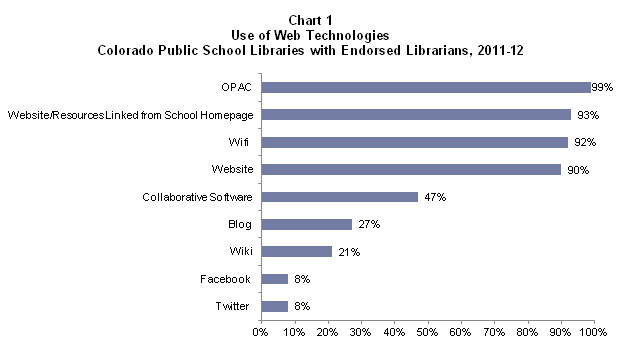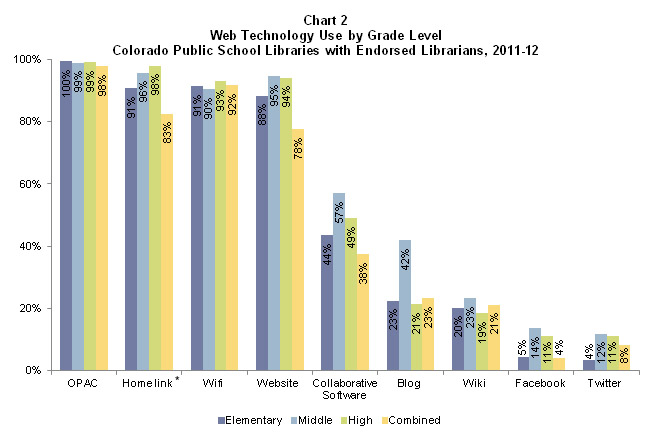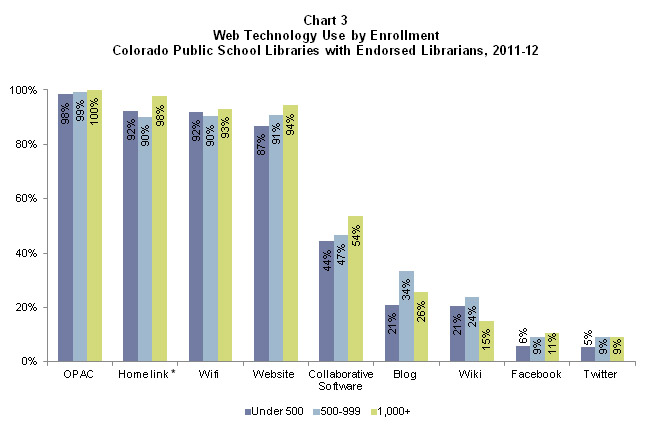For the 2011-2012 school year, the annual Colorado School Library Survey included a new section to assess the degree to which school libraries use technology to communicate with students and assist them in accessing library resources. A total of 442 endorsed school librarians[note]School librarians/teacher librarians with Colorado Department of Education (CDE) school library endorsements.[/note] participated in the survey. Their responses show how prevalent various web technologies are in school libraries staffed by an endorsed librarian, as well as which types of schools are more likely to adopt these technologies.
Use of Web Technologies – All Schools
Of those Colorado public school libraries with endorsed librarians who completed the survey, almost all (99%) have online public access catalogs (OPACs), 93 percent have links from their schools’ homepages to their libraries’ websites/resources, and 92 percent have wireless Internet access available for students (Chart 1). Also, nine in ten (90%) of these libraries have websites. Collaborative software, such as Sharepoint, is used by almost one-half (47%) of school libraries with endorsed librarians. However, just over 1 in 4 of these libraries have blogs (27%), 1 in 5 have wikis (21%), and fewer than 1 in 10 have Facebook pages (8%) and Twitter accounts (8%). Clearly, school libraries are selective in this area, bypassing social media tools—or at least those asked about in this survey—in favor of other types of online presence.[note]Some school districts restrict the use of social media networks such as Facebook and Twitter.[/note]
Use of Web Technologies by Grade Level
With the exception of libraries at combined schools (i.e., schools that combine multiple grade levels, such as K-8, within a single facility), Colorado public school libraries are on the same playing field in their use of basic web technologies. Approximately 9 out of 10 high school, middle school, and elementary school libraries with endorsed librarians have OPACs, websites, links from their schools’ homepages to their libraries’ websites/resources, and wireless internet access for students (Chart 2). However, middle school libraries outpace all other school library types in their use of Web 2.0 technologies. More than one-half (57%) of middle school libraries use collaborative software, two-fifths use blogs (42%), almost one-fourth (23%) use wikis, and slightly more than 1 in 10 have Facebook pages (14%) and Twitter accounts (12%). Libraries at combined schools are the least likely to have 5 of the 9 web technologies discussed here: OPACs (98%), links from their schools’ homepages (83%), websites (78%), collaborative software (38%), and Facebook (4%).
*Library website/resources linked from school homepage
Use of Web Technologies by Enrollment
Use of web technologies by Colorado public school libraries with endorsed librarians also varies according to enrollment (Chart 3). Libraries serving schools with enrollments of 1,000 or more (large schools) are most likely to have all of the web technologies except for blogs, wikis, and Twitter. Libraries that serve schools with enrollments between 500 and 999 are most likely to have blogs and wikis, but are either equivalent to or fall behind the large schools in regard to the other technologies. Meanwhile, school libraries serving schools with enrollments of fewer than 500 students (small schools) are least likely to have all of the web technologies except for links from their schools’ homepages, wifi, and wikis.
*Library website/resources linked from school homepage
Conclusion
Maintaining an online presence certainly offers advantages to school libraries, especially in situations when personal interaction is not feasible. Becky Russell, School Library Content Specialist at the Colorado State Library, remarks, “By using and providing leadership in technology, school librarians can help their students and staffs become more digitally literate and provide access to library resources 24/7. In addition, school librarians’ use of interactive web technologies can offer collaborative opportunities and feedback that will help them improve their chances of providing outstanding and essential customer service.” Though few can deny the benefits of maintaining an online presence, not all school libraries can afford to commit to this endeavor, especially when funding—and therefore staff—is stretched thin. During the coming years, it will be important to track web technology adoption trends over time, to determine whether more school libraries are able to overcome budgetary and other obstacles to take advantage of virtual tools and the learning and communication opportunities they afford.


